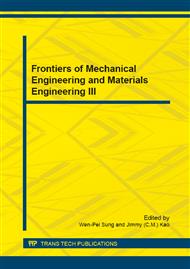p.227
p.231
p.235
p.239
p.244
p.248
p.253
p.258
p.262
Study on 6H-SiC Crystal Substrate (0001) C Surface in FA-CMP Based on Diamond Particle
Abstract:
Through experimental study on the role of the free abrasive in chemical mechanical polishing, in this paper, four different types of abrasive which were chosen were used for the research of material removal rate(MRR) and surface quality of SiC single crystal . Finally ,Diamond abrasive which is considered was the most suitable for chemical mechanical polishing(CMP) abrasive of SiC Crystal Substrate. With diamond Particle polish pad polishing, it is draw a comparison result on the influence of the free abrasive and consolidation abrasive for the material removal rate and surface quality of 6H-SiC. The results showed that: the MRR is 140nm / min, the material removal rate if fixed abrasive chemical mechanical polishing(FA-CMP) more than three times that of traditional CMP, fixed abrasive chemical mechanical polishing pad, are involved in a large proportion of micro abrasive cutting, can greatly improve the material removal efficiency. And results from the test procedure, the FA-CMP surface has scratches after more technical problems for the polishing pad, the surface damage is relatively free of abrasive chemical mechanical polishing is more serious.
Info:
Periodical:
Pages:
244-247
Citation:
Online since:
January 2015
Authors:
Price:
Сopyright:
© 2015 Trans Tech Publications Ltd. All Rights Reserved
Share:
Citation:


